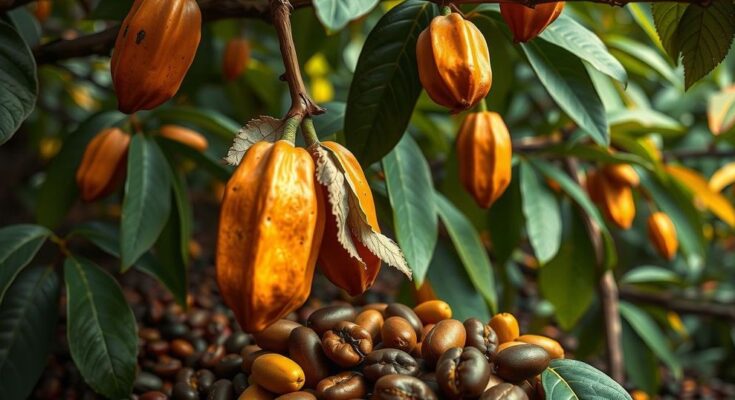Papua New Guinea experienced a record year for cocoa exports in 2024, totaling PGK1,233 million. However, forecasts predict that coffee will regain its leading position by 2025, with projected exports reaching PGK1,580 million. Global conditions and yield fluctuations greatly influence both markets, with cocoa experiencing supply constraints while coffee demand remains strong.
In 2024, Papua New Guinea achieved record cocoa export revenues of PGK1,233 million, exceeding cocoa revenues for coffee, which totaled PGK989 million. This marked a historic shift; however, it may be temporary, as cocoa supply cannot be rapidly increased due to the historically low crop sizes. Predictions indicate that coffee will outpace cocoa once again in 2025, driven by anticipated high yields and competitive pricing.
Coffee production in PNG is expected to rebound in 2025 following a previous low-volume season. The cyclical nature of coffee yield, alternating between high and low years, plays a significant role in the market dynamics. With recent increases in coffee prices due to adverse weather conditions affecting Brazil’s crop, coffee is projected to reclaim its status as the leading export.
Forecasts for 2025 indicate coffee export revenues could reach PGK1,580 million, significantly overshadowing cocoa’s projected PGK1,363 million. Overall, total export revenue is expected to surpass PGK3 billion, exceeding the prior year’s record. The sharp consumer demand for coffee, coupled with reduced production in key global markets, is expected to bolster PNG’s coffee market.
Global cocoa production faced challenges with a 13.1% decline in 2024, attributed to drought conditions and diseases affecting cocoa yields, particularly in Ghana and Côte d’Ivoire. Despite a surge in prices to USD8,214 per ton due to sustained demand, market predictions suggest a continuation of tight supply, which is likely to keep prices elevated.
As 2025 approaches, cocoa prices rallied again in January, breaking records at USD11,159 per ton. However, favorable weather conditions could lead to improved cocoa crop yields, potentially moderating price expectations. Nevertheless, a majority of experts predict that average cocoa prices will settle around USD8,000 per ton due to persistent supply constraints.
In terms of coffee exports, while PNG exported 827,100 bags in 2024, this figure represented a 14.1% decrease from the previous year. Current projections show that despite limitations in the first half of the 2024-25 season, a resurgence in coffee exports is anticipated, reaching one million bags in 2025. The expected increase in coffee prices will incentivize farmers to market their produce more aggressively.
Regarding cocoa, PNG’s exports rose modestly to about 39,000 tons in 2023, an increase of 1.3% year-over-year. However, challenges, such as farmers transitioning to alternative crops like balsa wood, have hindered significant growth in cocoa production. Despite record prices, production volumes have been capped due to these factors, though increased agricultural investment may stimulate growth.
Looking forward, the coffee sector is projected to regain its dominance in export receipts as favorable market conditions include higher export volumes and stronger pricing. Coffee historically has outperformed cocoa in generating export revenues for PNG, and this trend is anticipated to continue into 2025, where coffee’s resilience is expected to maintain its competitive edge in the global market.
In summary, Papua New Guinea’s cocoa exports achieved record revenue in 2024, but coffee is poised to reclaim the lead by 2025, driven by increasing yields and higher prices. Global market trends suggest that cocoa will face persistent supply challenges, while coffee demand remains robust, indicating a favorable outlook. The anticipated financial performance for both commodities underlines the vital role these products play in PNG’s economy, with coffee likely regaining its position as the primary export once more.
Original Source: www.fijitimes.com.fj




